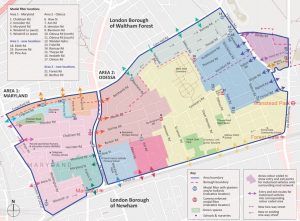The Australian Walking and Cycling Conference was held on October 1-2, 2020.
We were enthralled by active transport initiatives locally and globally, and made plans to start implementing some ideas here in Adelaide!

AWCC moved online this year to due to COVID with a high rate of participation across the country. Presentations ranged from government, academic research, community organisations and provocateurs. While there’s too much to cover here, there were some strong themes that emerged throughout the conference that were particularly relevant to Bike Adelaide and our members.
ADVOCACY
Professor Trevor Shilton from the Heart Foundation lent on thirty long years of advocacy with the Tobacco Control Lobby on the efforts to reduce smoking, including his declaration that for the Heart Foundation, time and money spent on advocacy has resulted in the best return on investment.
He described advocacy pithily – “Advocacy is mobilising influence to create change.”
We require advocacy when the evidence for change is not matched by policy commitment (in smoking, there was a twenty year lag) and where community demand is ahead of political action.
“To a politician, one letter is a complaint and five letters is public opinion”
It is important to recognise your own voice (it’s more important than you might think) because we are all advocates! Prof. Shilton’s remark about politicians reinforced all of our roles in the community and making yourself heard.
“Advocacy is both a science and an art”
Changing people’s minds takes more than just presenting them with facts. We need to take the evidence for the benefits of cycling (there is a lot) and communicate it with creativity, empathy and passion.
So what might we advocate for? Dr. Paul Kelly (University of Edinburgh) presented his promising research which reviewed methods for smaller community groups and organisations to implement as part the UK Cycle Nation project. As a result, he produced a map with 93 practical types of actions, which could be determined by working through the specific problems faced by these groups.
As a process, it functioned as virtual toolbox of opportunities, where one could apply a range of interventions to the situations we have probably all faced at one time or another as a cyclist.
SYSTEMS CHANGE
Researcher Megan Sharkey (University of Westminster, SpaceForHealth Australia) and Claire Pascoe (New Zealand Transport Agency) looked at systems change and understanding the complex network of relationships in advocating political change and how we can use that positively.
“Is this a technical problem, or an adaptive challenge?”
For cycling, we’re not just trying to fix technical problems (such as the bike lane should go here), we’re trying to contextualise and address that within a much broader system of human mobility and occupation.
For instance, the construction of successful and well used cycling and walking paths go hand in hand with a compact urban form, vibrant and well designed streets, public artwork, the limiting of car use and speed, the provision of public transport, ebike subsidies, workplace facilities, etc.
With this in mind, there are lots of groups and organisations that share broadly similar goals and legislative/bureaucratic hurdles. Think about what other groups in the community would benefit. Coalition building is the purposeful assembly of these diverse groups, working toward similar outcomes. A campaign actively supported by such a coalition is much more likely to get traction in the media and the places that matter. Imagine the Adelaide Coalition for Human Mobility, held together by the principles of ecological sustainability, human health, the inclusive use of public space and roads, urban design, equitable allocation of space and funding for cyclists, public transporters and walkers.
In engaging with these complex systems, you need also need politicians and the broader public to understand and to see where they fit, to find their own meaning in change, and to want to be part of it. The Workshop (New Zealand) have produced a fantastic guide for advocates to speak about and promote active transport.
TACTICAL URBANISM & COMMUNITY ENGAGEMENT
Tactical Urbanism is an approach to improving neighbourhoods by implementing low cost, temporary and scalable interventions. It has well and truly evolved from its grassroots beginnings and is being embraced by governments at all levels as a way to engage communities in a process of change and improvement.
For instance, in Australia, we’ve seen pop up bike lanes trialled in Melbourne, Sydney, Brisbane to great success and internationally, is implementing 650km of bike lanes. Unfortunately, Adelaide is conspicuously absent from this list!
Importantly, engagement with the public is an essential part of the process. If a measure doesn’t work, it’s easy to adapt, alter or remove it. It is not a linear process, it is experimental and often doesn’t fit within the usual structures of urban planning or long term strategy. It is fast, messy, requires constant communication and buy-in from the community, politicians and bureaucrats alike.
An exciting example is the London Low Traffic Neighbourhoods – to prevent rat-running through and encourage the use of the road space by pedestrians, cyclists, a range of physical and timed filters were added to the entrances/exits of areas (traffic cells). Drivers could enter and exit an area, but not travel through it. As a result of COVID, many people shifted from public transport to private cars and many councils have been on the front foot in reallocating public space to encourage safe active travel modes.
Newham Council (London) Low Traffic Neighbourhood
Caroline Butler-Bowdon from the NSW Dept. of Planning, Industry and Environment presented the Streets as Shared Spaces grants, temporary activation projects for communities to improve local streets and public spaces. These are short term projects funded up to $100000 and medium term projects up to $1 million.
“Projects are intended to test and build the case for more permanent changes. Councils will lead the projects and consult with the community and stakeholders to evaluate success and make changes as needed.”
The scheme was Initiated and funded from a state government level. Applications were submitted by local governments (where the knowledge, and community participation exists) and approved by the department.
Streets as Shared Space proposal (Manly, NSW)
COVID
COVID was the word on everyone’s lips, but it wasn’t all bad news. There has been a rediscovery of cycling through the crisis and people have been enjoying it recreationally, as well as for shopping and commuting.
As we saw in cities worldwide, governments could act quickly and explore changes to urban environments and the situation has presented opportunities to build back, better.
However, one thing COVID has done is exacerbate existing inequalities in our society. Infrastructure, projects and policies that support active transport help to address mobility issues for the most vulnerable, those who can’t or don’t want to drive, those who don’t feel safe to cycle or walk but want to and even those who didn’t know they wanted to until their friends and neighbours did.
There were some rich veins of thought that ran through the conference including advocacy, systems change, community participation; the influence of COVID and the projects it has catalysed. Walking and cycling away, one could feel buoyed with the presentations of positive outcomes for active transport and communities across Australia; in Adelaide the potential for change is profound.
Resources
Public Health Advocacy Institute of Western Australia
International Union for Health Promotion and Education
Blueprint for an Active Australia
Streets as Shared Spaces (NSW)
The Workshop New Zealand How to Talk about Urban Mobility and Transport Shift
London Cycling Campaign Campaigning Resources



